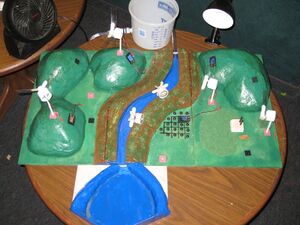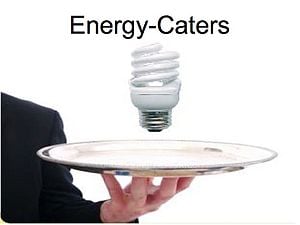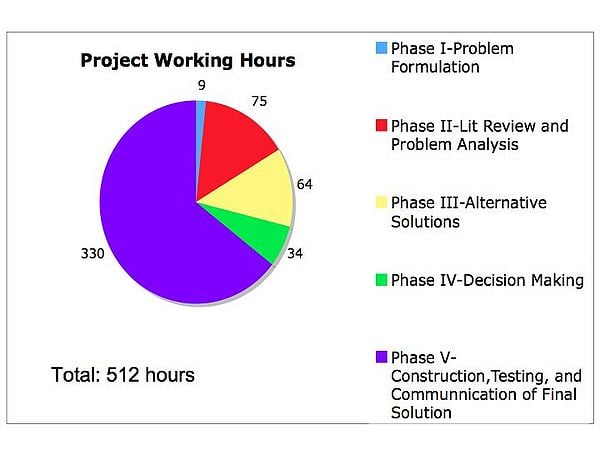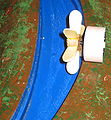


During the Spring semester of 2010, a group of four students (Team Energy-Caters) were assigned a twelve week long design project in the Engineering 215 Introduction to Design course at Cal Poly Humboldt. Team Energy-Caters were sponsored by their client Redwood Coast Energy Authority of Eureka, CA., and given the task to further educate local students on renewable energy in the best-fit design they felt appropriate. The objective and criteria of the design project was developed by team Energy-Caters in order to produce a teaching aid for middle school audience on renewable energy resources. The final product, Modeling Renewable Energy, was researched, constructed, and tested with the goal of being implemented in classrooms for years to come.
Project Overview[edit | edit source]
Modeling Renewable Energy is a design consisting of a three-part lesson plan.
The first part is a written activity for the students. The activity includes informative pamphlets on five renewable energy resources: solar, wind, wave, hydroelectric, and biomass. To go along with the introductory pamphlets is a theoretical scenario describing an area in need of an energy source. The students have a worksheet they complete for this activity.
The second part is a hands-on activity for the students. One topographic model, as shown in Figure 1, is provided to the class. The students place miniature solar panels, wind mills, and water mills on the model and connect them to a voltmeter to witness them producing energy. There are various spots on the model for the renewable technologies to be placed; each spot changes the amount of energy produced. There is a worksheet involved with this activity.
The third part is a class debate. The students are split into five groups, each assigned one of the renewable energy resources. The students use the information from the previous activities to develop arguments on why their renewable energy is best-fit for the modeled area. The class debate is structured where each group rotates in presenting until each person in each group has said their argument.
Problem and Objective[edit | edit source]

The Design Objective: To fill the given boxes with an effective, educational aid focused on renewable energy that is interactive and maintainable for a middle school audience.
The Black Box Diagram, shown in Figure 2, depicts the state of the world before and after the final design is implemented.
Criteria[edit | edit source]
The criteria are based off the objective and are weighted in terms of importance relating to the final solution. Each criteria has a corresponding constraint that must be met.
| Criteria | Weight | Constraint |
|---|---|---|
| Level of Educational Value | 10 | The project must be able to effectively communicate age-appropriate information on five renewable energy resources to the audience. |
| Construction Practicality | 9 | The entire project must be complete within the deadline |
| Durability | 8.5 | The project must last one year of weekly interaction my middle school students. |
| Level of Fun | 8 | The project must be enjoyable, engaging and encouraging to the students' learning. |
| Safety | 7 | The project may not obtain any potentially hazardous materials or equipment. |
| Ease of Use | 6.5 | The project must be easy to implement in a classroom for both instructors and students |
| Cost | 6 | The entire project must cost less than $400 |
| Aesthetics | 6 | The project must be an attractive final project |
| Ease of Maintenance | 5 | The project must be easy to maintain, store, and replenish materials for multiple uses. |
Final Product[edit | edit source]
The final product of Modeling Renewable Energy contains three parts. The process of which Energy-Caters decided upon these three parts is described in the linked document. Instructions for implementing the lesson plan for each part is also included in the document.
-
This image shows how the model's structure is made from wood and the amount of cuts of wood it takes to complete the base of the project.
-
This image shows the the model partial complete. The mountains are complete and the project has a coat of paint.
-
This image shows the project in it's final stages of construction. All the major aspects of the project are complete. The entire model is painted and has a coat of fiberglass resin to protect it from water damage. All the renewable energy-sources are complete and functioning.
The first gallery shows the progress of the building of the model.
-
This image shows a solar panel, bought from SolarMade, which is attachable to the model with velcro.
-
This image shows a wind mill made , wooded dowel, and wooden propellers with plastic extensions.
-
This image shows a water mill built from a turbine generator from KidWind, PVC
-
This shows the ocean section of the model which catches the water that flows through the river. The corks on a string represent wave energy buoys.
-
This image shows the Biomass power plant section that is included on the model.
-
This image shows a voltmeter, bought from KidWind, used to measure the previous renewable energies.
The second gallery displays the attachable components of the model.
Costs[edit | edit source]

The materials involved in constructing the final project cost a total of $230.06. A detailed list of the price and quantity of each material is listed in the table below. The materials were purchased from local stores, such as Almquist Lumber, Ace Hardware, Michael's Arts and Crafts; and Eureka RC and Hobby shop, as well as online companies, such as SolarMade and KidWind.
| Construction Costs | |||
|---|---|---|---|
| Materials | Quantity | Price ($) | Total ($) |
| Turbine generators | 6 | 3.00 | 18.00 |
| Fan | 1 | 15.99 | 15.99 |
| Solar panels | 4 | 3.50 | 14.00 |
| Sheet of 1/4" plywood | 1 | 13.99 | 13.99 |
| Voltmeter | 1 | 12.50 | 12.50 |
| Lamp | 1 | 10.79 | 10.79 |
| Two part foam | 2 | 4.99 | 9.98 |
| Model grass | 1 | 9.87 | 9.87 |
| Vinyl Spackling | 2 | 4.89 | 9.78 |
| Paint | 7 | 0.99 | 6.93 |
| Plaster of Paris | 1 | 6.89 | 6.89 |
| Fiberglass resin | 2 | 11.45 | 22.90 |
| Mini bird house windmills | 6 | 0.99 | 5.94 |
| Drain plug | 1 | 5.84 | 5.84 |
| Gorilla glue | 1 | 4.49 | 4.49 |
| Plastic tub | 2 | 2.24 | 4.48 |
| Tube valve | 1 | 4.31 | 4.31 |
| Wood glue | 1 | 4.25 | 4.25 |
| Velcro squares | 1 | 3.59 | 3.59 |
| Wire endings | 2 | 1.79 | 3.58 |
| Silicon caulking | 1 | 3.49 | 3.49 |
| PVC T joints | 3 | 1.16 | 3.48 |
| Spray paint | 1 | 2.89 | 2.89 |
| Sand paper | 6 | 0.45 | 2.70 |
| Paint brush | 3 | 0.90 | 2.70 |
| Vinyl tubing | 3 | 0.69 | 2.07 |
| 1/4" wooden dowel | 2 | 0.64 | 1.28 |
| Electrical tape | 1 | 0.71 | 0.71 |
| Wiring | 2 | 0.35 | 0.70 |
| Total ($) | 230.06 |
| Estimated Annual Maintenance Cost | ||||
|---|---|---|---|---|
| Material | Price ($) | Quantity | Approx. Time of Use (yrs) | Annual Cost ($) |
| Turbine generator | 3.00 | 6 | 4 | 4.50 |
| Solar panel | 3.50 | 4 | 2 | 7.00 |
| Voltmeter | 12.50 | 1 | 5 | 2.50 |
| Fan | 15.99 | 1 | 3 | 5.33 |
| Lamp | 10.79 | 1 | 3 | 3.60 |
| Paint | 0.99 | 5 | 1 | 4.95 |
| Fiberglass resin | 10.89 | 1 | 1/2 | 5.45 |
| Gorilla glue | 4.49 | 1 | 1 | 4.49 |
| Photo copies | 0.05 | 30 | 1/50 (week) | 75.00 |
| Total ($) | 112.80 |
The total number of combined hours that Energy-Caters contributed to completing Modeling Renewable Energy, as seen in Figure 3, is 512 hours. The design process was divided into five phases: Problem Formulation, Problem Analysis/Literature Review, Alternative Solutions, Decision Process, and Construction and Testing of the final solution. Details of each phase are located in the linked document.
The estimated annual cost to keep Modeling Renewable Energy operational is $112.80. The primary cost comes from making photocopies of the worksheets for the students. This estimate will vary depending on how often the design is implemented in the classroom.
Testing Results[edit | edit source]
The final solution, Modeling Renewable Energy, is a success in that it meets the objective as an effective and maintainable educational aid regarding renewable energy technologies geared towards middle school students and fits our criteria as a safe, durable, and practice teaching exercise. The final product and lesson plan was not able to best tested in a classroom setting, but was tested on individuals. The individuals were older than the middle school age, but they were able to complete the activities with no instructions, meaning that middle school students will be able to complete the activities with the help of both written and verbal instructions.
Authors[edit | edit source]
Final Document-Modeling Renewable Energy








